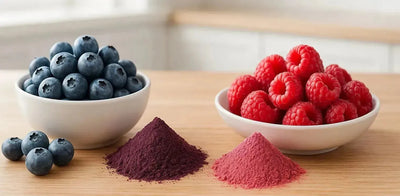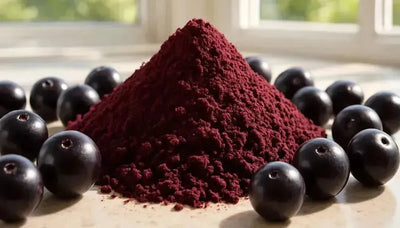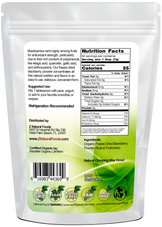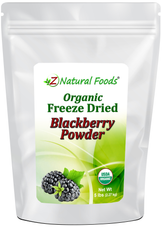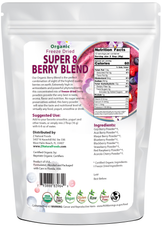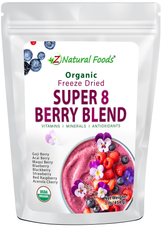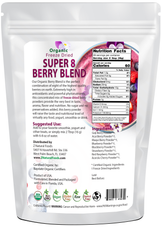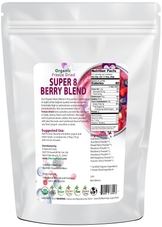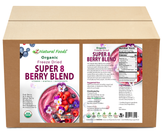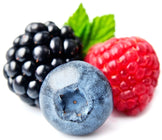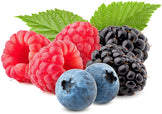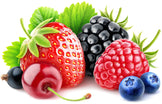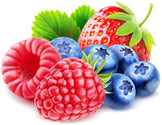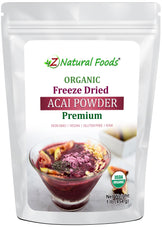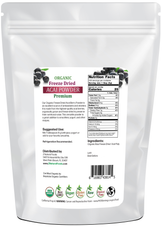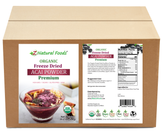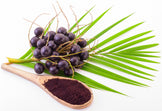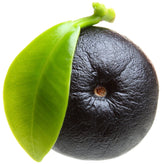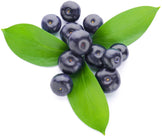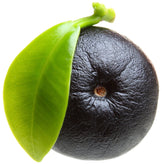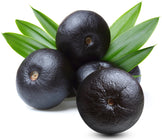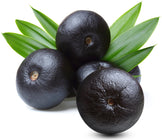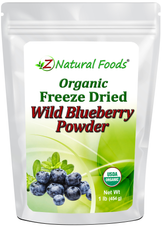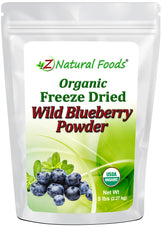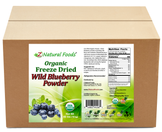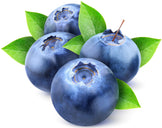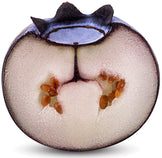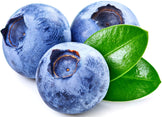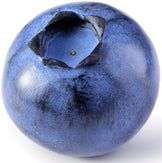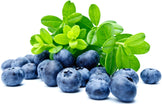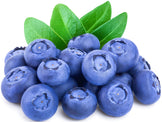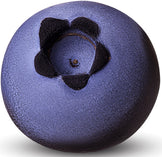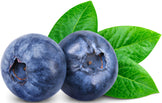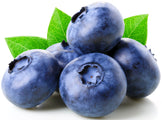Description
Description
Z Natural Foods takes pride in bringing customers a wide range of foods in their most versatile form, and our Organic Freeze-Dried Blackberry Powder is no exception.
Our blackberry powder is created through a fantastic freeze-drying process that preserves the fruit's natural nutrients and flavors.
When a food powder is made, it produces a shelf-stable end-product that creates exceptional versatility. Indeed, a powder is not the same as eating a food in its original form. However, the idea that we can’t replace that food with a powder to deliver its unique qualities is untrue.
Our freeze-dried blackberry powder has a mild, sweet, and tart flavor and dark, rich color that shows its mighty polyphenolic power and creates the potential for limitless culinary applications.
Two big reasons why customers like our organic freeze-dried blackberry powder
Today, we will look at the top reasons why people like our organic freeze-dried blackberry powder.
1) Versatility
When discussing a food's versatility, we refer to its ability to adapt or be adapted for various functions, from creating a new product and improving its flavor profile to significantly improving its nourishing capabilities.
Those improvements aim to create a cleaner, safer, and more nutritious food product that may support various biological functions with the same effect as the fresh version. Therefore, multiple elements must be considered when determining a food or product’s versatility.
While there are many natural ways to dry foods and preserve their nutritional qualities, including low temperature, shade, air, sun, and freeze-drying, the quality of the raw materials predominantly determines the final product.
Ultimately, preserving the incredibly nourishing qualities found in blackberries is best obtained through freeze-drying. Because berries perish quicker than most foods, this method preserves their structure and integrity and significantly extends their shelf life.
The shelf life of any food or product is directly linked to its moisture content. A freeze-dried product has an average of only 3% or less moisture content. So, freeze drying allows for greater versatility of the end product due to more accessible storage options and blending capability and supports the natural flavor profile of the fresh food version.
There are three primary advantages to using a freeze-drying method:
1) Freeze-drying creates the closest end product when presenting a whole food complex.
2) Freeze-drying food presents closest to the smell, taste, and texture of the fresh version of a food.
3) Freeze-dried foods allow you to customize your needs when creating a product, and freeze-dried berries can be left whole, chopped, or milled into a powder. All of these will still offer the nutritional value that comes from fresh produce.
However, to you, the consumer, the most critical aspects of versatility are the end product's shelf life, its ability to be used in various culinary applications, and its ability to improve flavor profile.
As stated above, a product's shelf life ultimately depends on the drying process and moisture content. Thanks to modern technology in food preservation, not only can we extend the shelf life of food without adding preservatives and chemicals, but we can also create an end product that is highly versatile and as nutrient-dense as the fresh version.
The flavor profile of blackberries has often been compared to the red grape, only sweeter, more intense, and more profound. Blackberries have a unique and sophisticated flavor profile that is slightly sweet and tart.
They are known as “the berry which has many flavors” with a wide array of undertones like woody, earthy, floral, and sulfurous. However, their sugar profile is almost equal amounts of fructose and glucose and a small amount of sucrose.
Therefore, pairing them with various liquors, chocolate, and the herbs mint, basil, sage, and thyme makes for a culinary delight.
The final aspect of blackberries' versatility regarding product creation and texture profile is that blackberries represent a high-quality source of fiber, as one cup contains a whopping 8 grams.
Per 100 grams, blackberries contain around 34 grams of insoluble fiber and 3 grams of soluble fiber. They are a food commonly used to produce jellies and jams as they are a rich source of pectin.
On average, they contain just under 1% pectin levels compared to the king of pectin: apples. Pectin, a naturally occurring polysaccharide starch from plant cell walls, is an excellent alternative to gelatin.
Therefore, blackberries can be used as a thickening agent in various recipes, from jams and jellies to sauces and soups.
For more information about our freeze-drying process, visit this helpful article:
What are the healthiest freeze-dried foods?
2) Nourishing Qualities
Modern research confirms the importance of adding a variety of foods with bright, vibrant colors that contain a wide range of potent polyphenolic compounds to support the repair process from the damage caused by stress, helping to create a more balanced internal environment.
Therefore, it should come as no surprise that blackberries are nutritional powerhouses that contain a wide array of unique compounds and are known for their deep, rich, and vibrant colors that profoundly affect human health.
It is essential to understand that to get protection through the nourishing qualities that berries provide, you would need to consume them in a wide array and daily. This can only occur through some level of supplementation.
The power of Flavinoids
Many health experts believe a diet focused on high amounts of flavonoids is critical to supporting a healthy aging process because these compounds are known as nature’s biological response modifiers.
There are over 8,000 different types of flavonoids found in nature. Based on the research, it does not seem to matter if you acquire them from food or supplements; what counts is the total daily amount you consume.
These experts believe we should consume at least 2000 milligrams of flavonoids daily sourced from various foods and supplements.
1) Polyphenols
Polyphenols are a term used to describe a general category of compounds found in a broad spectrum of fruits, vegetables, and tea that work as “reducing agents” along with other compounds known as antioxidants to support a healthy inflammation response and the body's ability to protect and repair damaged tissue caused by oxidative stress.
While over 8,000 polyphenols have been identified, some of the most common are flavonoids, flavonols, and anthocyanins.
The importance of discussing these various compounds allows you to more clearly understand the wide range and complexity of nourishment you are getting from these powerful foods.
2) Flavonoids
Flavonoids are a group of water-soluble polyphenolic secondary metabolites found in plants thought to provide health benefits through cell signaling (The process when a cell responds to a substance outside the cell through signaling molecules found on the surface of that cell) and antioxidant effects.
Secondary metabolites are substances manufactured by plants that make them compete in their environment, exerting a wide range of effects on the plant itself and the surrounding living organisms, including flowing, fruit setting, signal deciduous behavior, and acting as antimicrobials. Over 50,000 secondary metabolites have been discovered, and many modern medicines rely on them for their mechanism of action.
There are six major subclasses of flavonoids: Anthocyanidins, flavan-3-ols, flavonols, flavanones, flavones, and isoflavones. These account for around 60% of all polyphenols.
3) Flavonols
Flavonols are polyphenols belonging to the flavonoid family with a ketone group studied for their wide range of biological activities (antioxidant, antimicrobial, hepatoprotective, modulating inflammation, and vasodilation).
They primarily accumulate in the outer tissues (skin and leaves) of fruits and vegetables, are the building blocks of proanthocyanins (compounds attributed to the colors of fruits and vegetables), and are most widespread in the human diet.
4) Anthocyanins
Anthocyanins are a part of the flavonoid family of polyphenolic compounds. They represent the pigments that exhibit the bright red, purple, and blue colors found in fruits and vegetables. The six most common are Cyanidins, Delphinidins, Malvidins, Peonidins, Petunidins, and Pelargonidins.
A survey of various berries' antioxidant capacity and phenolic composition concluded that blackberries took second place on the winner's podium for having exceptionally high levels of anthocyanidins and proanthocyanins.
In conclusion, blackberry powder is an outstanding essential functional food that provides tremendous versatility and has a limitless number of important uses.
So, whether you want to pair it with your favorite beverages, create new and exciting culinary delights, or support your nourishment levels by adding one of the tremendous polyphenolic-based foods to your daily consumption, freeze-dried blackberry may be your all-in-one solution.
For more information about our Blackberry Powder, go here:
Organic Freeze-Dried Blackberry Powder
To review all of our Fruit Powders, go here:
